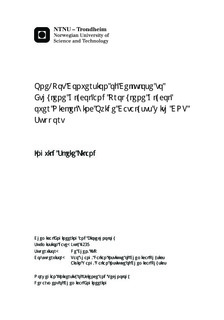| dc.description.abstract | Ni-Zn oxide catalysts with CNT support were prepared by the pechini method, and evaluated for the conversion of cellulose to polyols. The catalysts were characterized by XRD, SEM/TEM, N2 adsorption, temperature programmed oxidation, CO2 desorption and H2 Chemisorption. The experiments were conducted at DICP (Dalian Institute of Chemical Physics, China) and the study is based on the previous work done by the author at NTNU (Norwegian University of Science and Technology) the fall of 2012, in which four 20Ni-ZnO/CNT catalysts with ZnO-loading 26-46% were prepared. The four catalysts were brought to DICP and tested for the conversion of cellulose (reaction time, activity and selectivity). The Ni-ZnO/CNT catalysts completely converted cellulose under hydrothermal conditions, and the highest EG (32,8%) and 1,2-PG (15,2%) yields were obtained over the 20Ni-26ZnO/CNT catalyst. In order to investigate the function of the different components in the CNT supported nickel zinc oxide catalyst, 26ZnO/CNT, 20Ni/CNT and 20Ni/26ZnO catalysts were prepared and tested for the conversion of cellulose. Nickel promoted hydrogenation and a synergistic effect between the Ni and ZnO components were observed. Activated carbon was considered as an alternative to CNT support, and therefore two batches of 20Ni-26ZnO/AC catalysts were prepared. One batch was prepared by the pechini method, and the other batch was prepared by incipient wetness impregnation. SEM and TEM characterization indicated that incipient wetness impregnation resulted in better nickel dispersion than the pechini method for the preparation of activated carbon supported Ni-ZnO catalysts. The CNT supported 20Ni-26ZnO catalyst was superior to the AC supported catalysts, therefore further investigations were done to reveal the mechanism for cellulose conversion via the 20Ni-26ZnO/CNT catalyst. Sorbitol and mannitol feedstocks could be converted to EG and 1,2-PG over the 20Ni-26ZnO/CNT catalyst. Yield as a function of time was studied and the results indicate that the main pathway for the conversion of cellulose over the 20Ni-26ZnO/CNT catalyst happenes via hexitols (sorbitol and mannitol). Next, Ni-26ZnO/CNT catalysts with nickel loading 5-30% were prepared and tested for cellulose conversion in order to investigate the effect of nickel loading. The EG yield increased as the nickel loading increased. The highest EG yield, 34,6%, and 1,2-PG yield, 17,8%, was obtained over the 30Ni-26ZnO/CNT catalyst, thus a combined EG and 1,2-PG yield of 52,3% was achieved. Finally, 30Ni-26ZnO/CNT catalysts were prepared with different reduction temperature to study basicity as a function of reduction temperature. A correlation between basic sites, reduction temperature and product yield was found, and a reaction mechanism was suggested. The reusability of some of the catalysts was briefly tested, and discussions related to the results are presented in order to provide ideas for future studies. | nb_NO |

